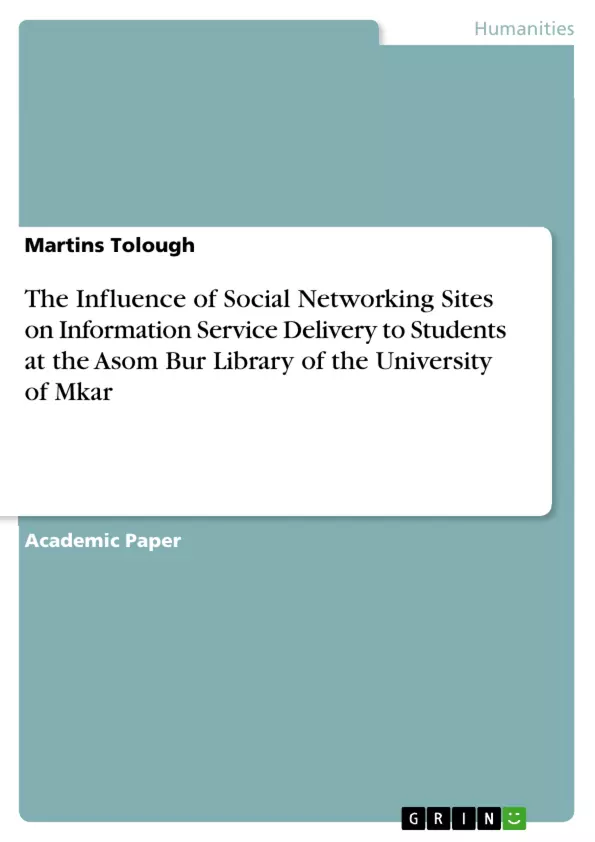This study investigates the influence of social networking sites on information service delivery to students of Asom Bur library of university of Mkar. Five objectives and five research question guided the study. The descriptive survey research was adopted for the study. A total of 958 registered users of Ason Bur learning resource center (library) of university of Mkar constituted the population of the study. A sample size of one hundred and sixty (160) students were randomly selected from the entire population of the study using proportionate random sampling technique. A self-developed questionnaire was used to obtain information. Data collected were analyzed using mean scored and standard deviation.
Finding revealed that, high percentage (50%) of the students mainly use social networking sites for social activities, only 20% percentage of the population use social networking sites for education. Findings further revealed that to benefit the rich potentials of social networking sites, students should spend less time socializing on them and utilize them for more for school-related activities and worthwhile events. It was also recommended that the university management through the library should encourage the students in the use of other social networking sites like Skype, LinkedIn, MySpace, Google Classroom and Zoom Meeting so that their knowledge will be widened, students should include the use of Google Classroom to the list of social networking sites they explore to reap its benefits. Though students use social networking sites frequently (daily and weekly), care must be taken to avoid them from using them when lectures are ongoing. This will help to curb the extent to which students are distracted during lecture periods. The university library through the library should encourage other methods of service delivered to student such e-books, posting photos, videos, voice over protocol and others. Also, the University management through the library should ensure the provision of basic information needed by academic community, faster and effective information service delivery, independent and life-long learning and provision of information necessary to improve quality of teaching.
Inhaltsverzeichnis (Table of Contents)
- DEDICATION
- ACKNOWLEDGEMENTS
- ABSTRACT
- CHAPTER ONE: INTRODUCTION
- 1.1 Background of the Study
- 1.2 Statement of Problem
- 1.3 Purpose of the Study
- 1.4. Research Questions
- 1.5 Significance of the Study
- 1.6. Scope of the Study
- CHAPTER TWO: REVIEW OF RELATED LITERATURE
- 2.1 Introduction
- 2.2 Conceptual Framework
- 2.3 Empirical Studies
- 2.4 Summary
- CHAPTER THREE: RESEARCH METHOD
- 3.1 Introduction
- 3.2 Research Design
- 3.3 Area of the Study
- 3.4 Population of the Study
- 3.5 Sample and Sampling
- 3.6 Instrumentation
- 3.7 Validation of Instrument
- 3.8 Method of Data Collection
- 3.9 Method of Data Analysis
- CHAPTER FOUR: INTERPRETATION, ANALYSIS AND DISCUSSION
- 4.1. Introduction
- 4.2. Analysis and Interpretation
- 4.3. Discussion of Findings
- CHAPTER FIVE: SUMMARY, CONCLUSION AND RECOMMENDATIONS
- 5.1. Introduction
- 5.2. Summary
- REFERENCES
- APPENDIX
Zielsetzung und Themenschwerpunkte (Objectives and Key Themes)
This research explores the impact of social networking sites on information service delivery to students at the Asom Bur library of the University of Mkar. The primary goal is to investigate the extent to which these platforms are being utilized for educational purposes by students and identify potential benefits and challenges associated with their use.
- Influence of social networking sites on information service delivery
- Students' usage patterns of social networking sites for educational purposes
- Potential benefits and challenges of social networking sites in an academic setting
- Recommendations for optimizing the use of social networking sites to enhance library services
- The role of university management and libraries in promoting effective social networking site integration
Zusammenfassung der Kapitel (Chapter Summaries)
Chapter One provides an introduction to the study, establishing the background, problem statement, purpose, research questions, significance, and scope. Chapter Two presents a comprehensive review of relevant literature, including a conceptual framework and analysis of empirical studies related to social networking sites and information service delivery in academic libraries. Chapter Three outlines the research methodology employed, including the research design, population and sample selection, instrumentation, data collection methods, and data analysis techniques. Chapter Four delves into the interpretation, analysis, and discussion of the findings, presenting key insights derived from the research data. Chapter Five summarizes the study's key findings, conclusions, and recommendations for future research and practice.
Schlüsselwörter (Keywords)
Social networking sites, information service delivery, academic libraries, university students, educational technology, library management, research methodology, data analysis, empirical findings, recommendations.
- Quote paper
- Martins Tolough (Author), The Influence of Social Networking Sites on Information Service Delivery to Students at the Asom Bur Library of the University of Mkar, Munich, GRIN Verlag, https://www.grin.com/document/1367622



